
 topics
topics
 download media
download media
 search
search
| Pre 1845 | 1845-1880s | 1890s-1910s | 1920s-1940s | 1950s-1990s | 2000s-Present |
Agriculture in the Millennium 2000s-Present








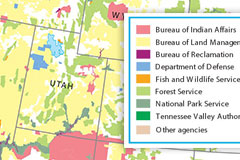



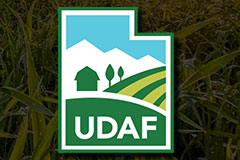



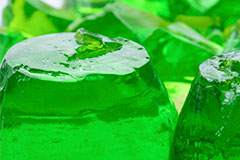



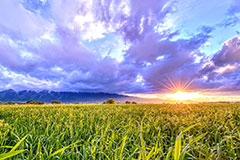

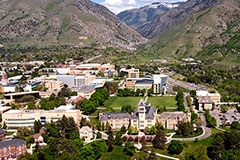


What would you like to find?

Downloadable Media: Agriculture in the Millennium
Imagery





Video
Audio











What makes Utah unique? Take a look at some of Utah's state symbols that are rooted in Utah history and agriculture.

Utah's State Symbols
- State Emblem: Beehive
- State Cooking Pot: Dutch Oven
- State Fish: Bonneville Cutthroat Trout
- State Flower: Sego Lily
- State Folk Dance: Square Dance
- State Fruit: Cherry
- State Grass: Indian Rice Grass
- State Insect: Honey Bee
- State Mineral: Copper
- State Rock: Coal
- State Vegetable: Spanish Sweet Onion
- State Historic Vegetable: Sugar Beet
Questions
Based on Utah's history, why do you think these items or products were selected as state symbols?
What other items or agricultural products would you select as a state symbol for Utah?

Following Utah's entry into the new millennium, the number of Utahns living in rural areas continued to drop to just 11 percent. Although the number of farms increased to more than 16,000, the size of those farms decreased to an average 669 acres. This meant that 11.1 million acres, or 21 percent of Utah's total land, was farmland. While cattle and milk remained the state's most important livestock products, hogs, mink pelts, and eggs were also important. Hay, used for feeding dairy cows, continued to be Utah's most important crop. With the urban population growth, the sales of greenhouse and nursery products, like trees, shrubs, and flowers increased significantly. As Utah moved into the 21st century, people concerned about the loss of farmland began organizing efforts to preserve what was left. Concerns about food safety, the long-term effects of pesticides, and questions related to genetically modified foods, led to a growing demand for sustainable agriculture, organic foods, and locally grown products. To help stimulate the economy and stem rising food costs caused by high transportation expenses, the state of Utah introduced a large marketing campaign to promote "Utah's Own." The campaign encouraged Utahns to purchase food produced in Utah and in their own communities. Increasing economic uncertainty gave rise to countless farmer's markets and new companies selling bulk foods for emergency food storage. Will the new millennium lead to a large-scale movement by Utahns to return to the self-sufficiency of their pioneer heritage, or will we continue to become ever more connected to the global marketplace? Will we work harder to protect Utah farmland and support those who raise and grow our food or will we buy more of our food from foreign countries? What changes and challenges lie ahead for the next century of Utah agriculture?
As a program of the Utah Department of Agriculture and Food (UDAF), Utah's Own strives to connect consumers with local farmers, ranchers, food artisans, and other agricultural producers. When Utahns buy from a Utah producer, the economy is strengthened; local jobs are created; food security is increased; and farms, ranches, farmland, and small businesses are preserved.

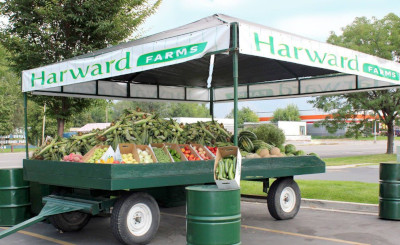
Utah's Own Directory
Search the Utah's Own directory and look through various Utah-owned businesses and producers.
https://utahsown.org/utahsownproducers
Questions
What familiar brands do you see?
Are there any Utah's Own farms, ranches, or businesses located in your county?
What other benefits come from purchasing Utah's Own products?
Food is a central element of culture and Utah is home to many culture-specific foods, dishes, and recipes.

Utah Food Folklore
Watch this video about Utah Food Folklore.
Questions
Read about Utah's top 10 signature foods here.
Do you agree with this list of Utah's top 10 foods?
What food(s) would you add to the list?

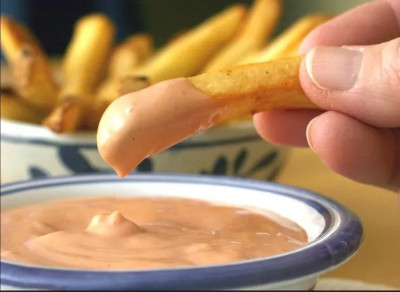
Fry Sauce
This creamy, pink dipping sauce has been a Utah favorite for decades. While its origin isn't completely clear, fry sauce is believed to have started in a Utah Arctic Circle. One popular story claims two high school students in Provo first created the iconic sauce in Provo. Ron Taylor and Max Peay both worked at Stan's Drive-In (a franchise of Arctic Circle at the time). In Ron Taylor's own words, "Back in 1954 when I was a sophomore in high school, I was hired by Bob Peay who was running a new Arctic Circle on 9th East in Provo. One evening, Max Peay, Bob's younger brother, and I were working together. When we weren't busy, we would often try making ourselves new things that weren't on the menu when we got hungry. We deep fried bananas, we made Strawberry Short Cakes using Twinkies, and all sorts of other things. One night Max and I decided to try to find something to go with our French fries besides ketchup. We ended up mixing a bit of mayonnaise with the ketchup and liked it a lot. We started sharing it with our friends when they came and asking them to try it and see if they liked it. They did. And it wasn't long until a lot of our customers were asking for that "French fry sauce stuff" instead of ketchup. In time, we started serving it instead of ketchup unless they asked us to do otherwise, which wasn't often." Whatever its origin may be, the recipe for fry sauce usually contains two essential ingredients: mayonnaise and ketchup. Some may add pickle juice, mustard, sugar, garlic, and other secret ingredients. Whether you love it or you hate it, fry sauce is a Utah staple that continues to connect people throughout Utah.
Questions
How can food bring people together?
Why does something like fry sauce create a connection for Utahns?
What other meals or dishes are unique to Utah's culture?
This is the Plate

Collegiate Ice Cream
Both Brigham Young University (BYU) and Utah State University (USU) have their own creameries that feature unique ice cream flavors designed to celebrate each of the schools' unique cultures, history, achievements, and more. Founded in 1888, USU has always had an operating creamery, but by 1922, students on campus could actually learn how to make cheese and ice cream. In 2022, Aggie Ice Cream celebrated their 100th birthday with new, limited-time only, ice cream flavors each month. Today, some of Aggie Ice Cream's signature flavors include "Aggie Blue Mint," "Aggie Bull Tracks," "True Aggie Night," and "Aggie Birthday Cake." The BYU Creamery currently offers 43 different flavors, including their signature flavors "Bronco's Cocoa Bean" and "LaVell's Vanilla"--each named after former BYU football coaches. It may be undecided on which collegiate creamery is the best in the state, but they do have one thing in common: each creamery uses their ice cream to celebrate important traditions, milestones, and people in their schools.
Questions
Explore each of the college's creamery pages.
Have you tasted any of the colleges' signature ice cream flavors?
Does your family have a favorite creamery?
This is the Plate
In Utah, the Bureau of Land Management (BLM), the Fish and Wildlife Service, National Park Service, and the Forest Service manage federal lands for many purposes related to preservation, recreation, and the development of natural resources. Federal lands are classified as multiple-use public land, which means everyone can access public lands whether they are hiking, camping, fishing, hunting, or ranching. Sixty-three percent of Utah's land is federally owned by various federal land agencies. Public lands continue to see a significant increase of environmental, agricultural, and recreational use which can lead to disagreements and conflict between federal agencies, ranchers, and the public.

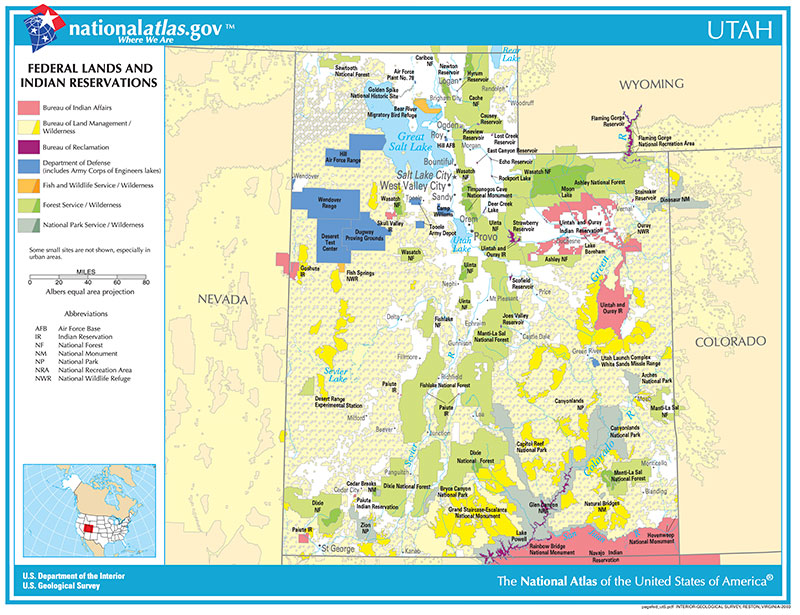
Federal Lands in Utah
Questions
How does public land use benefit Utahns?
What are the consequences of public lands use?
How can people who share different views and opinions effectively access and use public lands?
Utah is the second driest state in the nation. Because of this, most of our state's issues are often water-related. In Utah, the growing population, agriculture, and tourism are all greatly impacted by "The Greatest Snow on Earth." Utah's winter snow not only provides scenic skiing, but is critical in order to replenish our reservoirs and provide farmers, ranchers, and citizens with water during the dry, hot summer months. The leaders in the Utah legislature estimate that population growth will overtake water availability by the year 2040 if we do not change our consumption and usage.
The Utah Journey

A State of Emergency
Dry soils from a mild winter reduce spring runoff effectiveness because soils soak up the snow melt and spring runoff before it can reach reservoirs, streams, rivers, and lakes. Most recently, Utah has been impacted by the two driest years on record. On April 21, 2022, Governor Spencer J. Cox issued an Executive Order declaring a state of emergency due to drought. At the time of this declaration: 99.93% of the state was experiencing severe drought or worse; all 29 counties were experiencing some level of drought; Utah had been in a drought eight of the past 10 years; three of Utah's top 42 reservoirs were less than 20% full, and two of Utah's top 42 reservoirs were less than 5% full. During this state of emergency, Utah farmers and ranchers faced significant cuts to their water supply. The Utah Department of Agriculture and Food (UDAF) expresses a strong emphasis on the importance of supporting local farmers and ranchers while clearing public misconceptions. "It's true that agriculture is a significant user of water in Utah. It's easy to remind people that the water farmers and ranchers use provides food, dairy, meat, and fiber for us all. What many people don't understand are the ancillary benefits of agricultural use. Agricutural production and water use not only sustains crops and livestock, but also:
- recharges aquifers through flood irrigation, keeping water levels up in household and municipal wells
- provides base flows for many of our rivers and streams due to return flows from flood irrigation
- provides open spaces and feed for wildlife on fields and water for ducks, geese, pheasants, and other waterfowl on flood irrigated land
- creates a cooling effect for nearby communities
- maintains and keeps open many of the trails used for recreational purposes that were created for ranchers to trail livestock herds summer to winter range
- and provides the life supporting water sources that Utah’s diverse wildlife populations depend on through stock water tanks, water troughs, and many other water projects maintained by farmers and ranchers.

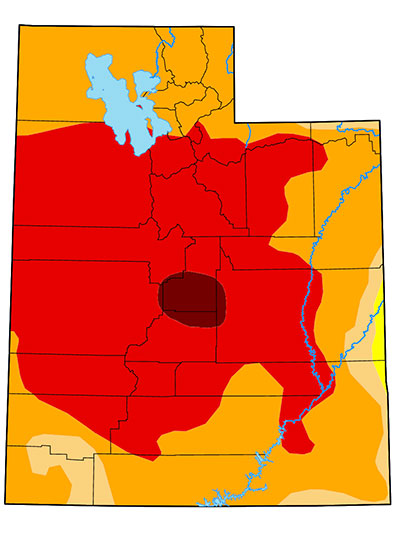
Utah Drought Monitor
Look at the current Utah Drought Monitor.
Questions
What is the current drought situation for your county?

Water Conservation Districts
This web page shows all nine water conservation districts in Utah. Water use is measured in gallons per capita (person) per day. Each region shows water usage per capita per day in 2015, and the projected water usage goals for the year 2030.
Study the maps on the page and answer the questions.
Questions
What is the 2030 water conservation goal for each person in your region?
What are some ways you can practice conserving water indoors and outdoors?
Why is it important for us to have water conservation goals for the future?
Wildfires have always affected those living in the West. As Utah's population continues to grow, wildfires significantly impact the lives of humans, disrupt economies, and require money from state and local budgets. In 2007, the Milford Flat Fire burned over 300,000 acres. This was the largest wildfire in Utah's history that was started by natural causes. The smoke from this fire caused many accidents and pollution that lasted for many weeks. Most recently, the Brian Head Wildfire in 2017 burned 72,000 acres. In Utah, wildfire "season" runs from June 1st to October 31st each year, when the state is at the highest risk for wildfires. Many factors, however, can contribute to longer fire seasons including droughts, tree mortality from pine beetles, and invasive species such as cheatgrass, that allow fires to ignite easily and spread rapidly.

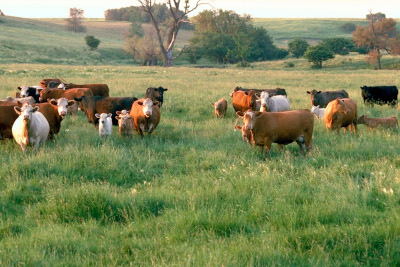
Can Cows Prevent Wildfires?
Researchers with the University of California Cooperative Extension studied how much fine fuel (grasses and other plants known to start fires) cattle eat and how livestock grazing affects flame activity. Research concluded that without livestock grazing, there would be "hundreds to thousands" of additional pounds of fine fuels per acre of land, which could lead to "larger and more severe fires." Cattle and sheep play an important role in reducing the buildup of grasses and other fire fuels that contribute to catastrophic wildfires.

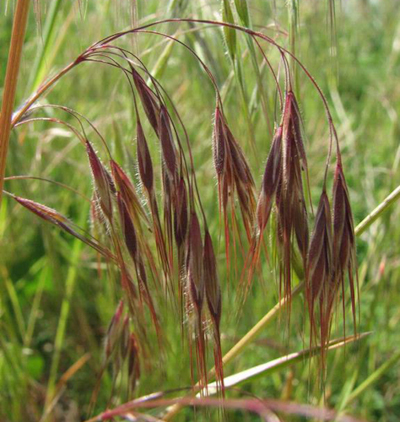
Utah's Fuel for Fire
Wildfires in Utah have plenty of fuel. An invasive grass species known as "cheatgrass" has overwhelmed Utah's ecosystems. Why is cheatgrass so invasive over other perennials? Cheatgrass cheats. It adapts easily to different soils and environments and will steal any available water from native perennials before they begin to germinate. It is considered a winter grass and has evolved to capitalize on water very early in the year. Utah is now covered in a highly prolific winter grass that dies off early and leaves the state covered in a dry grass that is ready to spark. The U.S. Forest Service and conservation scientists have been trying to beat cheatgrass for decades, but haven't been too successful. Even a wildfire is unlikely to kill off cheatgrass seed beds. So far, applying a pre-emergent herbicide proves to be one solution that kills cheatgrass, but it also kills native seeds as well.
Questions
What are some preventative measures we can take to stop human-caused wildfires in grassy areas?
Utah is home to 10.8 million acres of farmland. Alfalfa hay, beef cattle, dairy cows, sheep, barley, and various fruits are among the top commodities produced in Utah. Because of Utah's geographic diversity, annual rainfall varies greatly. Each year, Utah receives approximately 12 inches of rain, making Utah the second driest state. Drought-resistant crops and dryland farming methods help Utah farmers with crop production. In Utah, the growing season ranges from 60 days in northern Utah to 190 days in southern Utah. Many agricultural businesses and restaurants in Utah rely on locally grown commodities produced by Utah farmers and ranchers. Typically, successful businesses are located close to high-producing farms and counties. Well-known dairy processing plants like Gossner Foods and Schreiber Foods are located in Cache County where many dairy farms can be found. Utah County is known for producing peaches, apples, and tart cherries; it is here you will find well-known fruit companies like Rowley's Red Barn and McMullin Orchards. Various fruit stands and businesses can also be found along "Fruit Way" in Box Elder County. Orchards in Utah thrive along the Wasatch bench where ancient Lake Bonneville left behind well-aerated, fertile soil.

2017 Census of Agriculture
Every five years, the U.S. Department of Agriculture (USDA) and the National Agricultural Statistics Service (NASS) release a Census of Agriculture, which provides a detailed report of U.S. farms and ranches in each state. This data is commonly used to show the importance of agriculture at the county, state, and national levels; compare the income and costs of production; provide data about the demographics and well-being of Utah producers; evaulate agricultural historical trends; measure the usage of modern technologies; plan for emergencies such as drought or disease outbreak; analyze the current state of food, fuel, and fiber production; and much more. According to the 2017 agricultural census, there are 18,409 farms in Utah, 10,811,604 acres of farmland in Utah, and the average size of farms in Utah is 587 acres. The 2022 Census of Agriculture is scheduled to be released in the summer of 2024.

Utah Department of Agriculture and Food: Annual Summary Report
Each year, the National Agricultural Statistics Service (NASS) and the Utah Department of Agriculture and Food (UDAF) release an annual summary report that provides a detailed look at Utah's agricultural production. This publication is provided to help inform farmers, ranchers, and the public about activities and services within UDAF. It also includes budgets to help farmers and ranchers evaluate the potential success and profitability of various agricultural products.
Browse through the Utah Department of Food and Agriculture (UDAF) annual report.

Where does Utah Rank Nationally?
In 2021, Utah ranked 37th in farm gate sales. Click here to see where other states rank in farm gate sales.
Questions
Which state ranks #1 in farm gate sales?
What factors contribute to this high ranking?

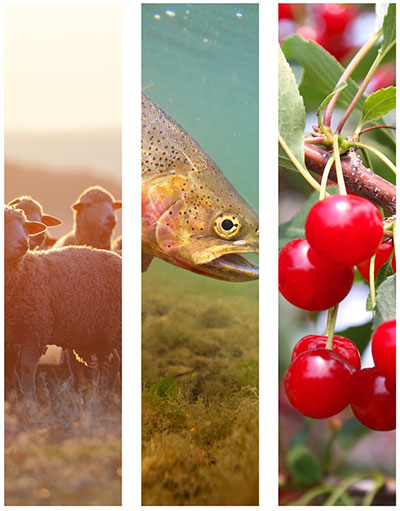
Sheep, Trout, and Cherries
Nationally, Utah ranks 5th for sheep and lamb production, 3rd for wool production, 7th in trout production, and 2nd for tart cherry production.
Questions
Out of these top agricultural commodities, which do you find most suprising?
Why?
This year marked the 100th year in operation for the Utah Department of Agriculture and Food. For the past century, UDAF has proudly supported agriculture and food producers.

UDAF Turns 100
Click here to watch a clip about the history of Utah Department of Agriculture and Food.
Then answer the questions.
Questions
What have been some focuses of UDAF the past 100 years?
Why is it important for Utah to have a department dedicated to agriculture and food?
Does UDAF benefit those that are not farmers or ranchers? Why?
As Utah's only land-grant institution, Utah State University is responsible to "educate the state." From sustainability and climate studies to agriculture and business, Utah State research changes lives everywhere. Faculty researchers at Utah State University are recognized nationally and internationaly for their expertise, and in 2021, Utah State recorded a record $368.5 million in research awards. What kind of research has happened at Utah State University?

Institute for Air, Land, and Water
Utah State University is building new pathways to engage policy makers with important research in land, water, and air. The institute is an interdisciplinary initiative designed by President Noelle Cockett to bring together two critical discussion spaces—USU’s research programs and state, county, and city governments—to create a positive impact for Utah. USU envisions a Utah with a high quality of life for our citizens that values and optimizes our state’s shared resources while managing continued growth.
Questions
Explore the 2022 Report to the Governor written by USU's Institute for Land, Water, and Air.
Why is it important for Utah to have an institute dedicated to land, water, and air?
How does this benefit Utahns?


Cloning of the Mules
In 2003, Utah State University and the University of Idaho successfully produced three genetically identical mules through cloning. "Utah Pioneer" was one of three cloned mules, all of which were born heathly and normal. Utah Pioneer's surrogate mother (a horse) carried the mule for 346 days before birth. Under natural circumstances, mules are sterile animals who cannot reproduce. The cloning of a sterile animal could open up other opportunities in the agricultural community.

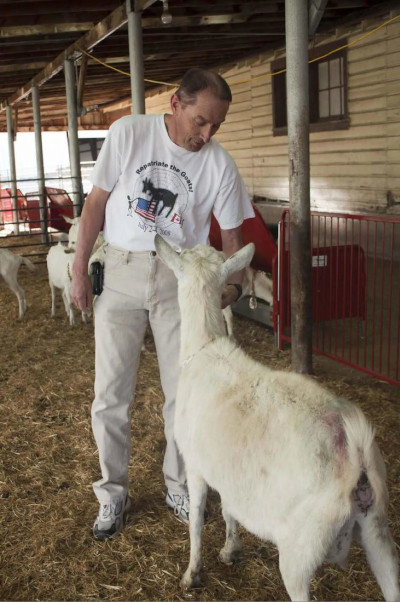
From Milk to Silk: Spider Goats and Spider Silk
Spider silk is a valuable resource. Dragline silk from spiders is 100 times stronger than natural ligaments, 10 times stronger than natural tendons, more elastic than nylon, and can be used to replace Kevlar. Therefore, spider silk is considered an ideal material because of its versatile use. However, while it is useful, there are limitations in realistically producing it. First, spiders cannot produce large quantities of spider silk and second, they are nearly impossible to “farm” because of their cannibalistic nature. As an alternative, scientists have turned to biotechnology to find an alternative method of producing spider silk. Within the genome of a spider is the DNA code for the protein responsible for producing silk. Under the direction of Randy Lewis at Utah State University (originally at University of Wyoming), regular dairy goats have been used to produce spider silk. This is done by copying the silk-making gene in a spider’s DNA and splicing it into a goat’s DNA. This gene splicing gives goats the ability to produce the spider silk protein in their milk. These spider goats are then milked (just like any other milk goat), and the spider silk protein is extracted from the milk. The extraction takes place by freezing the milk and separating the fat. The thawed milk is then sifted, and the remaining fat molecules separate from the smaller silk proteins. In addition to goats, Utah State University has also started gene splicing with other transgenic organisms including alfalfa hay and silk worms.



